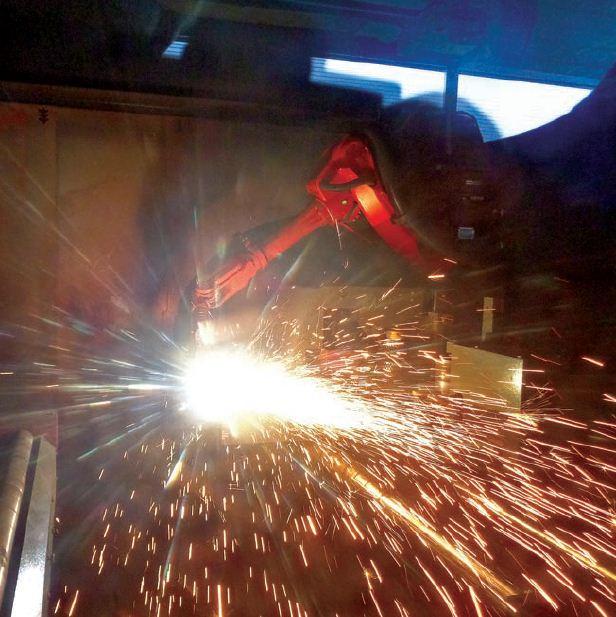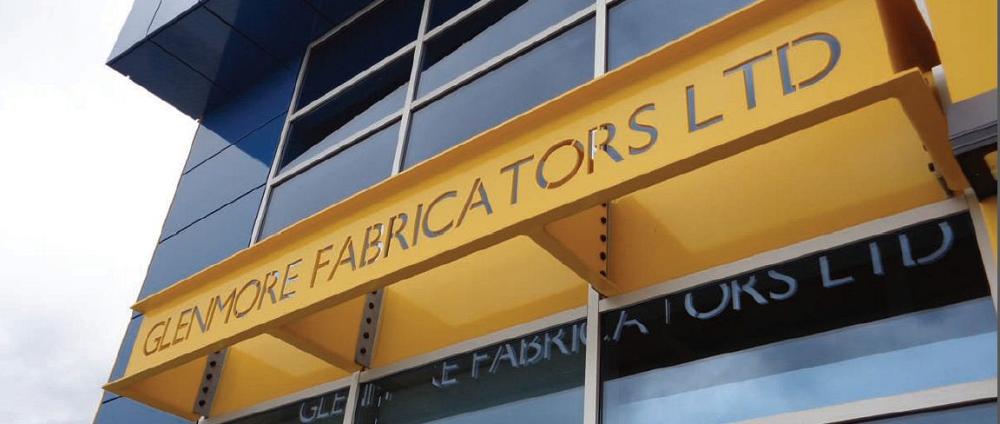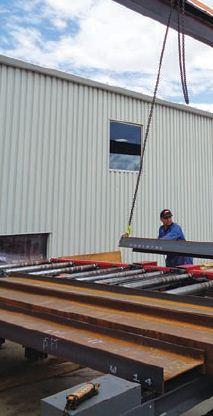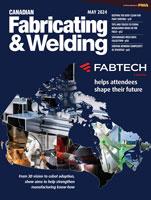- FMA
- The Fabricator
- FABTECH
- Canadian Metalworking
SME success stories: Building a boom town
Glenmore Fabricators is making its mark on one of Canada’s fastest growing cities.
- By Nick Healey
- August 18, 2014
- Article
- Fabricating
It’s hard not to notice the scope of expansion going on in Calgary these days. Housing developments dot the city’s perimeter, a brand new tower gleams in the city centre, and roads are being built faster than GPS systems can manage. It’s definitely a different city than your father’s Cow Town was – and as a result of the boom, someone has had to step in to get this city built. Enter, Glenmore Fabricators.
Glenmore Fabricators has been something of a parable for the pace and style of construction in the city. Glenmore started as a miscellaneous shop in the year 2000, handling around $1 million worth of business a year. Over the last 14 years, as the city has grown, the shop has grown in lock step to become a company with two locations, around 100 employees, and one that handles roughly $30 million worth of business on an annual basis.
Sitting in the boardroom of the semi-finished upstairs at Glenmore’s new facility in southeast Calgary, it’s obvious that Jason Gillen, the shop’s general manager, is a big reason for its success. Gillen started at the shop in 2004 and never looked back, helping establish the company as one that would be unafraid to go after the big business, and exciting projects.
“When you look around at these square boxes, you know, there’s not much ‘vision’ and that’s what we call ‘gravy’,” Gillen says.
“Then there’s the times where they come up with the funkiest stuff, and they come to us and they say ‘how do you make it real?’ and that’s where we specialize. We do a lot of the complex work. A lot of the things most fabricators won’t touch.”
Two notable projects for the company have been ‘ornamental’ fixtures for Calgary’s recent downtown centerpiece, The Bow tower, where the pieces were 60,000 pounds and 6 stories high. Another is and the Mount Royal Conservatory, which he and Glenmore’s production manager My Lam are particularly happy about.
We had the largest crane in Canada there,” Gillen said. “We actually couldn’t even assemble the whole truss on the ground, we actually had to assemble most of it in the air.”
“We had to bring in steel and it was 342 pounds per foot. It was monstrous and so those were actually embedded in concrete,” says Lam.
The company is also establishing themselves as a busi-ness that can add value through their engineering exper-tise. This was part of the reason they decided to build a second location that could handle higher volumes of work.
“The market is starting to change and so are we,” Gillen says. “We built this shop so we could handle capacity within the market, but also to get into the design-build. We’re hoping to have an engineering firm.
“Most of (our engineers) have experience in consulting that help us do design builds – helping us get our customer their final package in time.”
The shop is so new (they moved in this past January) that some areas are still getting the finishing touches, but eventually it will be home to an in-house engineering firm. Gillen actually took a very hands on role in designing the layout of the shop, and incorporating their new Voortman machinery into what they do.
“Your flow is always to go through one machine and then go to the next and allow it to bypass if you don’t need it so you don’t create bottlenecks,” he says.
Gillen, like any good shop manager, seems to be relentlessly focused on efficiency. He explains that automation and efficiency are what took Glenmore to the level they’re at, and believes they can continue to follow that path on the road to more expansion.
“You’re always trying to find a more efficient way of doing something. We did a test here on some tubes, where we had to cut them in very complicated shapes. It did one tube in five minutes – we figured it was two hours for your best guy.”
“At my other fabrication shop if we do 20-30 pieces per shift, that’s pretty good. Processing wise, this (new shop) will probably do 120 pieces per shift.
“We’ve had guys fabricate something and they’ve cut the beam too short or they put the piece in the wrong spot. As soon as you put in the human value, you’ve created sources of error. We’re just trying to limit those sources of error so we can fabricate fast.”
Then of course there’s the issue of finding good labour in general – which was another reason Gillen chose to focus on automating, and simplifying processes as much as possible. He also laments the fact that the problem can be particularly trying in Alberta. Due to the nature of the oil and gas industry in the province, it’s not uncommon for your workers to suddenly bolt for the oilfields and go chase after higher wages.
He emphasizes that the simplicity of the new equipment was a key factor in their decision to base a lot of the new shop’s design around it.
“A lot of it’s pre-determined by creating batches and NC1 files so the operator is just pressing play,” Gillen says.

Glenmore’s General Manager, Jason Gillen, stands beside the control for the plasma unit of the firm’s Voortman line.
Giles Young, sales manager for All Fabrication Machinery, explains how Voortman machines are able to run in a fairly automated manner.
“As long as you put the correct beam on there, the machine will know because it’s in the file. If you put the incorrect beam on there, it’ll tell the operator,” Young says. “Guys aren’t running tapes anymore. That took a while to learn, to trust the machine, because any time you’ve got to run a tape and double check, now they’re finally like ‘okay the marks are good and we can weld on it.’”
Gillen elaborates further on the idea of taking a drawing and making it a reality.
“The equipment that we have now ‘talks’ to our detailed design software,” he says. “So the minute you take some-thing and you draw it, and you print it you’ve created a source of error. The person who’s interpreting the drawing can interpret it incorrectly. This goes right from our 3D modeling software and right into the machines.”
“The interesting thing about Voortman is they were fabricators and they started manufacturing equipment… so when they have a problem in the shop, they go up to R&D and say, ‘make the machine do this’.”
Since Glenmore itself is so big on custom work for its clients, they felt having machinery that was customizable was helpful as well. The shop has sawing, beam drilling, and robotic plasma on site, but choose to contract out a lot of the bending work they need done. They’re also considering adding robotic welding to the shop, but there are some challenges to implementing that, so for the time being they do mostly flux-cored, or stick welding when in the field.
Now, armed with the new shop and more capabilities, Glenmore has the capacity to go and acquire even more business – something that should suit them well in their booming city.
“We have a pretty big customer base that we service, and it’s tough because for the last 8 or 9 years we’ve only had the one shop, so we’ve been maxed out,” Gillen says.

Plasma cutting, and a streamlined workflow system have dramatically improved the shop’s productivity.
“Now that we’ve built this shop, we’ll service not only the customers, the general contractors, but some of the fabricators that want to do processing – where they want to cut some beam, have something drilled, and we’ll do that for them.”
Then there’s the added benefit for Gillen that he genuinely loves the work.
“We see a lot of different challenges out here. Fabrication is a hard job to do. Because the information is harder and the architects seem to be able to just dream up everything, but we’ve got a really good staff… we make everything real. I drive around the city, I see something and say, ‘hey, I did that building.’”
“There’s parts of the city that I won’t go to for a year, then I show up and it’s all new. I won’t even recognize it.” And the way things are going, there’s no doubt it’ll be that way for years to come – but at the rate Glenmore is growing, they may just recognize more and more of it as time goes on.
About the Author
subscribe now


Keep up to date with the latest news, events, and technology for all things metal from our pair of monthly magazines written specifically for Canadian manufacturers!
Start Your Free Subscription- Industry Events
Automate 2024
- May 6 - 9, 2024
- Chicago, IL
ANCA Open House
- May 7 - 8, 2024
- Wixom, MI
17th annual Joint Open House
- May 8 - 9, 2024
- Oakville and Mississauga, ON Canada
MME Saskatoon
- May 28, 2024
- Saskatoon, SK Canada
CME's Health & Safety Symposium for Manufacturers
- May 29, 2024
- Mississauga, ON Canada






















